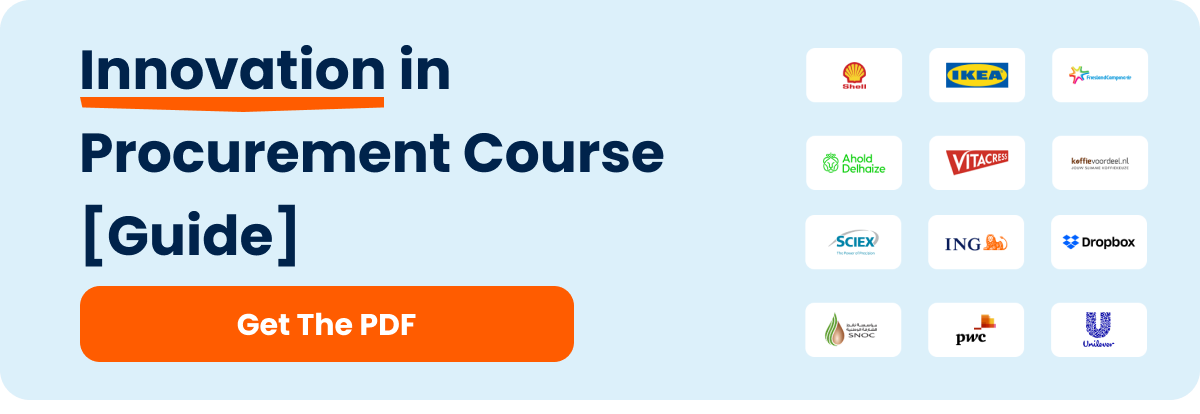Written by Marijn Overvest | Reviewed by Sjoerd Goedhart | Fact Checked by Ruud Emonds | Our editorial policy
Exploring the Areas of Innovation in Procurement [2025]
What areas can you explore innovation in procurement?
- Procurement innovation spans seven areas: product, process, service, business model, organizational, marketing, and technological innovation. Each improves efficiency, customer experience, and business performance.
- Implementing innovation strategies can help companies save money, work faster, improve product quality, and stay ahead of competitors.
- Companies should evaluate their current processes to identify areas for improvement. Starting with simple changes that deliver quick results is the most effective approach.
Innovation can be applied in many aspects of procurement, but not every change will deliver real value to a company.
In this article, we will focus on the seven most critical and impactful areas where innovation in procurement can drive value across different departments within an organization.
The 7 Types of Innovation in Procurement
1. Product Innovation
Product innovation is all about creating new products or enhancing current ones in order to address customers’ needs better. It is usually the most visible type of innovation and has a direct effect on customer satisfaction and revenue.
Example:
A procurement team sources new materials that can improve a product’s functionality or appearance, like using sustainable materials in packaging to attract environmentally conscious customers.
2. Process Innovation
Process innovation is focused on improving efficiency by streamlining workflows and procedures within a company. This innovation usually results in cost savings, shorter lead times, and improved product or service quality.
Example:
Automating procurement workflows to reduce manual tasks, decrease errors, and speed up order processing.
3. Service Innovation
Service innovation involves creating new services or improving existing ones to enhance customer experience. This is important for organizations that prioritize customer satisfaction and long-term loyalty.
Example:
Introducing a digital customer support system that offers real-time assistance while ensuring a more seamless and responsive interaction.
4. Business Innovation
Business model innovation reshapes how a company delivers value, from revenue generation to its fundamental operations. This type of innovation can be transformative, providing a strong competitive edge in the market.
Example:
Shifting from conventional supplier contracts to subscription-based supplier relationships, ensuring steady access to products and services at predictable costs.
Example:
Establishing cross-functional teams that integrate procurement, R&D, and marketing to streamline communication and speed up product development.
6. Market(ing) Innovation
Marketing innovation is about creating new ways to promote products and connect with customers. This can include innovating pricing structures, promotional campaigns, or distribution channels.
Example:
Implementing e-auctions to drive competitive pricing for high-demand products or utilizing social media channels to enhance brand awareness and engage customers with new offerings.
Example:
Using blockchain technology to enhance supply chain transparency and traceability to ensure that all suppliers comply with all the quality and regulatory standards.
Each of these innovation areas offers unique advantages, depending on an organization’s goals and industry landscape. Together, they form a strategic toolkit for driving growth, increasing efficiency, and elevating customer satisfaction.
The key to innovation is to focus on one area at a time. Start by identifying where the biggest opportunities lie or where quick wins (“low-hanging fruit”) can be found. By taking a step-by-step approach, new possibilities will naturally emerge along the way.
Innovation Perspectives Template

We have created a template to help you map out your organization’s innovation strategy. To fill this template, start by identifying your current position. Determine where your organization stands by marking the relevant focus areas (rows) and levels of innovation (columns).
Next, define your goals. Decide where you want to advance—whether that means shifting from incremental to radical innovation or expanding into new areas like technological innovation.
Use the template to spot gaps and uncover opportunities. This will help you allocate resources effectively and focus on the areas that will drive the most impact.
Lastly, revisit the template regularly to track progress and refine your strategy. Mapping out where you are now and where you want to be, creates a clear path forward. This helps you make informed decisions, anticipate challenges, and ensure your innovation efforts lead to meaningful, measurable results.
Conclusion
Innovation in procurement spans multiple areas, from product and process improvements to technological advancements and business model transformations. However, it’s most effective to focus on one area at a time. By taking a step-by-step approach, new ideas for innovation will emerge along the way.
Our template will help you in mapping out your current status, which will help you determine opportunities, and make strategic progress in your efforts. Using this will help you to manage resources more efficiently and focus on the areas that will produce the greatest influence.
If you want to explore more in-depth strategies and new ideas to improve procurement, then enroll in our Innovation in Procurement Course which will allow you to innovate your procurement process, creating more value for your company.
Frequentlyasked questions
What areas can you explore innovation in procurement?
Procurement innovation spans seven areas: product, process, service, business model, organizational, marketing, and technological innovation. Each improves efficiency, customer experience, and business performance.
How can the Innovation Perspectives Template help?
Our Innovation Perspectives Template can help you see your current innovation status, set goals, and track progress. Using it regularly can help you focus on the most important improvements.
How can a company decide where to start with procurement innovation?
Companies should look at their current processes and find areas that need improvement. It’s best to start with easy changes that can bring quick results.
About the author
My name is Marijn Overvest, I’m the founder of Procurement Tactics. I have a deep passion for procurement, and I’ve upskilled over 200 procurement teams from all over the world. When I’m not working, I love running and cycling.







